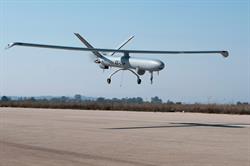Johns Hopkins APL Develops Algorithm Enabling UAVs to Avoid Collisions Written 10 January 2023

ExecutiveGov reports that Johns Hopkins Applied Physics Laboratory researchers “developed an algorithm that enabled fixed-wing unmanned aerial vehicles to avoid potential collisions in complex environments.” The study also “resulted in a new maneuvering capability that allowed the UAVs to launch in near-vertical takeoffs, eliminating the need for long runways or manual lift-off, the laboratory said Thursday.” To achieve the “predictive control algorithm, researchers equipped the fixed-wing vehicles with an onboard depth camera and NanoMap, a mapping system developed by the Massachusetts Institute of Technology.” The camera’s stereo feature “gave the UAV depth of perception and enabled triangulated collection of data, even in extremely constrained spaces and at a speed of 20 miles per hour.”
Full Story (ExecutiveGov)
